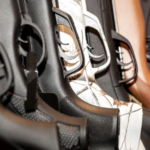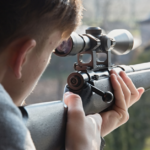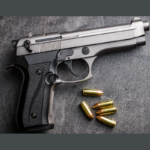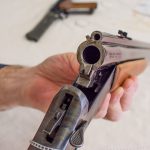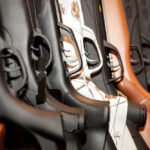Firearms Laws and Licences in New South Wales
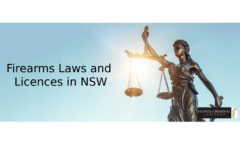
There are a number of stringent rules surrounding firearm licences in New South Wales.
Here’s a rundown of the rules.
Firearms Licences
There are five categories for firearms licences in NSW, not including Firearms Collector and Firearms Dealer, all of which apply to different firearms and uses:
- Category A — Air rifles, rimfire rifles, shotguns, or shotgun/rimfire combinations.
- Category B — Muzzle-loading firearms, centre-fire rifles, shotgun combinations, lever action shotguns with a magazine capacity of less than 5 rounds.
- Category C — Self-loading rimfire rifles with a magazine capacity of less than 10 rounds, self-loading shotguns or pump action shotguns with a magazine capacity of less than 5 rounds.
- Category D — Self-loading centre fire rifles, self-loading shotguns with a magazine capacity of more than 5 rounds, or pump action/lever action shotguns with a magazine capacity of more than 5 rounds.
- Category H — Pistols
Furthermore, there are restrictions for the Category C and D licences. The number of firearms authorised on a Category C licence are limited to one self-loading rimfire rifle and one registered shotgun. The number of firearms under a Category D licence is restricted to three registered firearms.
Applying for a Licence in NSW
Individuals who wish to apply for a firearms licence can do so online by gathering the following documentation:
- MyServiceNSW ACcount
- Proof of identity
- One of the following — firearms safety training certificate, previous firearms licence number, or current interstate firearms licence number
- Genuine Reason(s) — Sport shooting, recreational hunting, primary production, pest animal control, business or employment, rural occupation, animal welfare, or firearms collection.
- Credit card
How can I own a firearm in NSW?
In order to own, possess and/or use a firearm in New South Wales, a person is required to possess a valid firearms licence.
The NSW Police Force is responsible for issuing firearms licences and permits, and will also conduct checks to ensure firearms are stored in a legal manner.
A person might be refused a firearms licence in NSW if they:
- Have a criminal record
- Have been issued with an AVO or interim AVO
- Don’t have a ‘genuine reason’ for having a firearm
- Have not completed an approved firearms training course
- Are not considered a ‘fit and proper’ person
In order to support your application for a firearms licence, you will be required to provide evidence that you have a valid reason for possessing the firearm (such as for use for pest eradication). Relevant documentation can include:
- A copy of your tax assessment notice stating your occupation.
- A copy of contracts from clients who are employing you for your services, including payment details.
- A letter from a government agency stating that you are employed or authorised by them to control vertebrate pest animals.
- A certified copy of a trapper’s licence.
- If you are a primary producer, you will be required to provide Section 15 Certificate from the Livestock Health and Pest Authorities with the details of their pest control recommendations.
As well as documentation to support your genuine reason for owning a firearm, you will be required to meet other requirements before you can be issued with a firearms licence in NSW.
If you have never held a firearms licence before, you will be required to undergo an approved firearm safety and training course.
Once you have completed the training course, your certificate will need to be attached to your application for a firearms licence.
If you have previously been issued with a firearms licence for the same class of weapon, you may not need to undergo the safety training again.
Once in possession of a firearm, the licence holder must store it in compliance with the regulations. Ammunition, and if possible the gun’s firing mechanism, must be stored separately. Police are able to request an inspection of the storage set-up at any time.
Appealing against a rejected application for a firearms licence
If you are refused a firearms licence, or your existing firearms licence has been revoked, you will receive a written notice from police advising you of this.
If you are unsatisfied with the decision, you have 28 days from the time you receive the notice to request an internal review by the Commissioner of Police.
Information on how to go about an internal review will be contained on your notification.
If the internal review is unfavourable, you have 28 days from when you receive the outcome to lodge an Application for Administrative Review with the NSW Civil and Administrative Tribunal (NCAT).
Before you lodge your NCAT application, it is important that you carefully read both the original notice from police and the reasons for the outcome of the internal review.
If the refusal or revocation was a “mandatory refusal”, the NCAT will have no power to overturn it.
Grounds for mandatory refusal are listed in section 11(5) of the Firearms Act 1996 , and include:
- where you have been convicted of offences or other circumstances that are comprehensively listed in section 5 of the Firearms Regulation 2017 (NSW);
- where you are subject to an interim, provisional or final apprehended violence order;
- where you are subject to a firearms prohibition order; and
- where you are subject to being a registerable person under the Child Protection (Offenders Registration) Act 2000 (NSW).
Relevant offences and order will apply even if they occurred in another state or territory, or even overseas. Your notice of decision will advise you of your review rights.
Gun offences in NSW
A number of criminal offences apply to the unauthorised possession or use of firearms or related equipment
For the purposes of the below offences, a ‘firearm’ is as a gun, or other weapon, that is or was capable of propelling a projectile by means of an explosive, and includes a blank fire firearm, or an air gun, but does not include a paintball marker.
This definition extends to ‘imitation firearms’ which are objects that, regardless of colour, weight or composition, or the presence or absence of any moveable parts, substantially duplicate in appearance a firearm, but are not firearms.
The offence of unauthorised possession or use of firearm in NSW
Unauthorised possession or use of a firearm is an offence under Section 7A of the Firearms Act 1996 which carries a maximum penalty of 5 years in prison.
To establish the offence, the prosecution must prove beyond reasonable doubt that:
- You possessed or used a firearm, and
- You were not authorised to do so by a permit or licence.
Section 4 of the Act provides that you are in ‘possession’ if:
- You have custody of the firearm, or
- You have it in the custody of another person, or
- It is in or on any premises, place, vehicle, vessel or aircraft, whether or not belonging to or occupied by you.
Section 4A of the Act makes clear that possession includes where the item is in or on any premises you own, lease or occupy, or in your care, control or management, unless you satisfy the court that:
- It was placed in or on, or brought into or onto, the premises by or on behalf of a person who was authorised to do so, or
- You did not know and could not reasonably be expected to have known that it was in or on the premises, or
- The evidence otherwise establishes that you were not in possession of the firearm.
‘Premises’ is defined broadly as any place, vehicle, vessel or aircraft.
The offence of unauthorised use or possession of a pistol or prohibited firearm in NSW
Unauthorised possession or use of a pistol or prohibited firearm is an offence under section 7 of the Firearms Act 1996 which carries a maximum penalty of 14 years in prison.
To establish the offence, the prosecution must prove beyond reasonable doubt that:
- You possessed or used a pistol or prohibited firearm, and
- You were not authorised to do so by a permit or licence.
The definitions regarding possession, premises and firearm that apply to section 7A also apply to this offence.
A ‘pistol’ is a firearm that:
- is reasonably capable of being raised and fired by one hand, and
- does not exceed the dimensions prescribed by the regulations.
Schedule 1 of the Act contains a long list of ‘prohibit firearms’, including:
- Machine guns, sub-machine guns and other automatic weapons capable of shooting bullets in rapid succession,
- Self-loading shotguns, rim-fire and centre fire rifles,
- Firearms capable of discharging liquid, powder, gas, chemicals, flares or dye
- Canons and powerheads, and
- Firearms disguised as other items, such as walking sticks.
The offence of possessing ammunition without a licence or permit in New South Wales
Possessing ammunition without a licence or permit is an offence under section 65(3) of the Firearms Act 1996 (NSW).
To establish the offence, the prosecution must prove beyond reasonable doubt that:
- You were in possession of ammunition,
- You were not the holder of a licence or permit for a firearm that takes the ammunition, and
- You did not otherwise hold a permit for the ammunition.
The maximum penalty for the offence of unlawfully possessing ammunition is 50 penalty units or $550.
Ammunition is defined as including:
- Any article consisting of a cartridge case fitted with a primer and a projectile,
- Any article consisting of a cartridge case fitted with a primer and containing a propelling charge and a projectile,
- Blank cartridges, airgun pellets, training cartridges or gas cartridges, and
- Anything else that the regulations of the Act may define as ammunition.
The Act states that a firearm ‘take’ the ammunition if the ammunition can be safely fired in the firearm, whether or not that ammunition has the same calibre designation as that of the firearm.
Defences to firearm offences in NSW
If you are charged with a firearms offence or an ammunitions offence and are able to raise evidence of a legal defence, the onus then shifts to the prosecution who must prove beyond all reasonable doubt that the defence does not apply to the circumstances of your case.
If it is unable to do so, you are entitled to an acquittal; in other words, a verdict of not guilty.
Legal defences to forearms offences include self-defence, duress and necessity.
Self-defence is where you believed your actions were necessary to defend yourself or another person, or to prevent the unlawful deprivation of your liberty or that of another person, or to protect your property from being taken, destroyed, damaged or interfered with, or to prevent criminal trespass to your land, or remove a person criminally trespassing, and your conduct was a reasonable response to the circumstances as you perceived them at the time.
Duress is where your conduct arose due to an imminent threat made to you or someone close to you, in circumstances where the threat was continuing and serious enough to justify your actions.
Necessity is where you engaged in your actions to avoid serious, irreversible consequences to you or someone you were bound to protect, you honestly and reasonably believed you or the other person were immediate danger and your actions were a reasonable and proportionate response to the danger.
Firearms Suppression Orders
Under the Firearms Act police have the power to request a Firearms Suppression Order, which can be made by the New South Wales Police Commissioner at any time.
It prohibits a person from bearing a firearm, firearm parts, or ammunition on the basis that it is not in the public interest for the person to do so.
For example, recently, a man who made online threats to Brittany Higgins, her partner and her dog (and had a history of previous online threats), was made subject to a firearms suppression order.
Section 25 of the Firearms Act 1996 (NSW) requires a firearms licence holder to immediately surrender their firearms and their firearms licence to police if their licence is suspended, revoked or otherwise is no longer in force. The maximum penalty for failing to do so is 2 years imprisonment and/or a $5,500 fine.
It also states that a police officer is authorised to seize any firearm in the possession of a person if that person’s licence is suspended, revoked or otherwise ceases to be in force. A police officer is also authorised to seize the licence itself.
‘A firearms ban’ is another way of saying ‘suspension’ or ‘temporary cessation’ of a firearms’ licence. The Police Commissioner can apply for an order whether or not someone already has a firearm licence. If they don’t have a licence, the commissioner’s order would therefore mean that a person would not have a gun licence application accepted or processed.
Firearms prohibition orders
In New South Wales, the Police Commissioner has the power to enact a Firearms Prohibition Order (FPO), under Section 74 of the Firearms Act.
If you have a criminal record or have been issued with an AVO at any time in the previous ten years, you may be prohibited from possessing a firearm. A firearms prohibition order can be given to anyone who the police believe is unfit to possess a firearm.
Under Section 74A of the Firearms Act 1996 (NSW) a police officer may:
(a) Detain a person who is subject to a firearm prohibition order, or
(b) Enter any premises occupied by or under the control or management of such a person, or
(c) Stop and detain any vehicle, vessel or aircraft occupied by or under the control or management of such a person, and conduct a search of the person, or of the premises, vehicle, vessel or aircraft, for any firearm, firearm parts or ammunition. These search powers may be exercised as “reasonably required” to determine whether a person subject to an FPO has committed an offence.
The maximum penalty for this offence is imprisonment for 14 years if the firearm is a pistol or prohibited firearm, or imprisonment for 5 years in any other case. The same penalty applies if the person acquires or possesses a component or part of a firearm. For acquiring or possessing ammunition, the maximum penalty is imprisonment for 5 years.
A person must not supply a firearm or firearm part to someone they know is subject to an FPO. The maximum penalty is imprisonment for 14 years if the firearm is a pistol or prohibited firearm, or if the firearm part is for a pistol or prohibited firearm, or imprisonment for 5 years in any other case. Supply of ammunition carries a maximum penalty of imprisonment for 5 years.
A person subject to an FPO must not knowingly have a firearm, firearm part or ammunition at their home. The maximum penalty is 50 penalty units ($5500) or imprisonment for 12 months, or both.
A person subject to an FPO is barred from visiting a firearms dealer, shooting range or firearms club. The maximum penalty is 50 penalty units ($5500) or imprisonment for 12 months, or both.
After being served with a Firearm Prohibition Order, a person has 28 days to request a review of the decision by the New South Wales Police Force.
If a review is denied by NSW Police, they must provide a detailed list of reasons for doing so. In this case, a person can apply to the NSW Civil and Administrative Tribunal (NCAT) for an administrative review of the decision.
Going to court for a firearms offence?
If you have been accused of a firearms offence and are going to court, call Sydney Criminal Lawyers anytime on (02) 9261 8881 for strong representation by an experienced criminal defence team who will explain your options, the best way forward and fight for the optimal outcome in your case.
Receive all of our articles weekly
Related Articles
RELATED LEGISLATION
- Section 7A Firearms Act 1996 | Offence of Unauthorised Possession or Use of Firearms Generally
- Section 7 Firearms Act 1996 | Offence of Unauthorised Possession or Use of Pistols or Prohibited Firearms
- Section 65 Firearms Act 1996 | Supply, Acquisition and Possession of Ammunition
- Section 36 Firearms Act 1996 | Unregistered Firearms
- Section 74 Firearms Act 1996 | Effect of Firearms Prohibition Order




